How to Complete Mount Kailash Trek?
- by Eric
- Last Updated: 2025-04-02
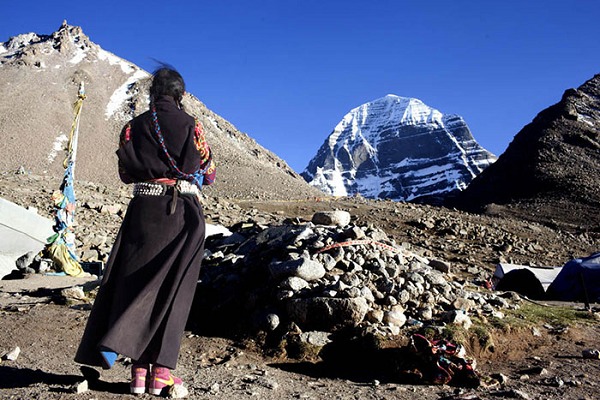 Mount Kailash is a world-recognized sacred mountain, and at the same time, it is recognized as the center of the world by Hinduism, Tibetan Buddhism, Bonism, and ancient Jainism. Mt.Kailash is not the highest mountain in this area, towering at around 6,714 meters, but it dwarfs the adjacent mountains in the region. According to legend, Hinduism believes that the mountain is the residence of Shiva; Jainism believes that the mountain is the place where its ancestor, Patriarch Rishabhanatha attained nirvana, the Bon religion originated from the mountain; and Tibetan Buddhism believes that the mountain is The residence of Cakrasaṃvara Tantra, who represents supreme happiness, in addition, the famous Mount Meru also refers to Mt.Kailash. Therefore, there are many believers who do kora here all year round. Kora is Tibetan, which means a circumambulation/circuit of a holy place.
Mount Kailash is a world-recognized sacred mountain, and at the same time, it is recognized as the center of the world by Hinduism, Tibetan Buddhism, Bonism, and ancient Jainism. Mt.Kailash is not the highest mountain in this area, towering at around 6,714 meters, but it dwarfs the adjacent mountains in the region. According to legend, Hinduism believes that the mountain is the residence of Shiva; Jainism believes that the mountain is the place where its ancestor, Patriarch Rishabhanatha attained nirvana, the Bon religion originated from the mountain; and Tibetan Buddhism believes that the mountain is The residence of Cakrasaṃvara Tantra, who represents supreme happiness, in addition, the famous Mount Meru also refers to Mt.Kailash. Therefore, there are many believers who do kora here all year round. Kora is Tibetan, which means a circumambulation/circuit of a holy place.
Pilgrims believe one circuit around Mt. Kailash can vanish your lifetime sin, 10 circuits around Mt. Kailash can exempt you from suffering reincarnation, and 100 circuits can make you go to heaven and become immortal. For Buddhists and Hindus, they pilgrimage clockwise. For Bon and Jainism, they do pilgrimage anticlockwise.
Trekking to Mount Kailash is one of the most strenuous and challenging treks for pilgrims in the world, at an altitude of around 4,700 meters. Here, Great Tibet Tour will guide you about how to complete the Mount Kailash trek.
At a Glance
- Route: kora around Mt.Kailash
- Distance: 52km(32.3miles)
- Duration: 3 days
- Start/End Point: Darchen
- Highest Point: Drolma-la Pass(5630 meters)
- Difficulty: Medium to difficult
- Season: May to October
- Permits: Tibet Travel Permit, Alien's Travel Permit and Military Permit
The Best Time to Have Kailash Kora
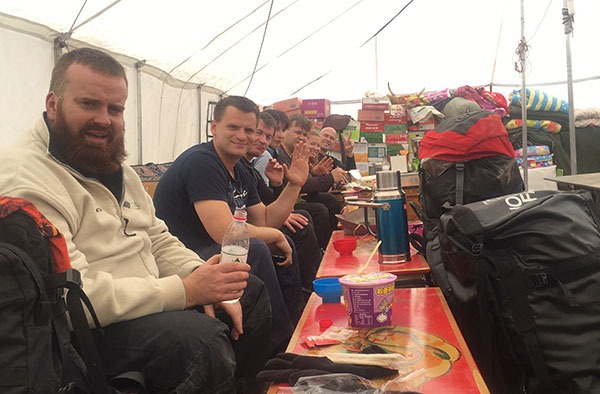 Among all the years, the Tibetan Horse Year is the best time to have Mt. Kailash Kora. It is said that the Horse Year in the Tibetan calendar is the year when Shakyamuni was born, so the merits and virtues of Mt.Kailash kora can increase many times than usual. In the Horse Year, one circuit of Mt. Kailashcan increases the merit and virtue by 12 times, which is equivalent to 13 times of a normal year, and the most effective and meritorious way. The most recent Horse Year is 2014, and the next one is 2026.
Among all the years, the Tibetan Horse Year is the best time to have Mt. Kailash Kora. It is said that the Horse Year in the Tibetan calendar is the year when Shakyamuni was born, so the merits and virtues of Mt.Kailash kora can increase many times than usual. In the Horse Year, one circuit of Mt. Kailashcan increases the merit and virtue by 12 times, which is equivalent to 13 times of a normal year, and the most effective and meritorious way. The most recent Horse Year is 2014, and the next one is 2026.
During the year, the best time for Mt. Kailash Kora is from May to October, when the temperature in Tibet gradually rises. So it's a comfortable period to have a kora, even in the Mount Kailash area at 4,700 meters, it is also suitable for outdoor activities. In addition, there is less precipitation from May to October. Although July and August is the rainy season in Tibet, there's no much rain at Mt.Kailash as it's located in Ngari region, far away from the marine climate. Its rainfall is less than that of Mount Everest Base Camp and other areas. In the case of little rain, the road conditions are much better and swamp areas are not easy to appear.
Another popular time to trek Mount Kailash is during the Saga Dawa Festival, which is the birthday of Buddha Sakyamuni. It is celebrated on the full moon day of the fourth Tibetan Lunar month(in either May or June). The highlight is to raise the new Tarboche Flagpole in place of the old one and pilgrims can grab the prayer flags and Khatas for happiness and auspiciousness.
How Long Does Mt.Kailash Kora Take?
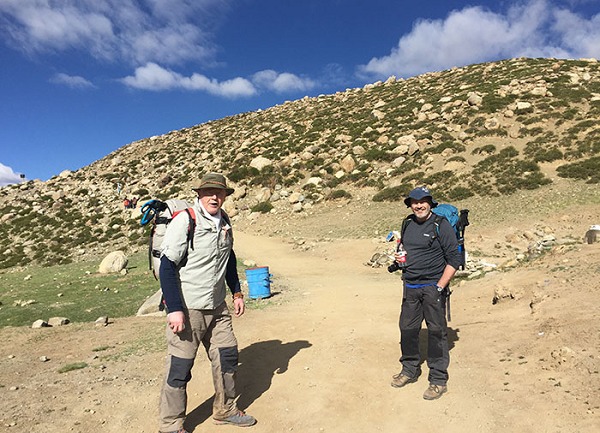 The Mt. Kailash kora starts from Darchen, and the whole trail is 52km. For ordinary tourists, it takes about 2 to 3 days to complete the kora. Dirapuk Monastery is usually the first day‘s accommodation. The whole journey from Darchen to Dirapuk Monastery is 20 kilometers(5km drive and 15km trek), mostly uphill, which can be completed by hiking at a constant speed for about 7 hours. After passing the Dirapuk Monastery, pilgrims need to pass over Dolma La Pass at an altitude of around 5,600 meters. Due to the high altitude, there's no accommodation in the close distance so pilgrims have to choose to stay overnight at Dirapuk Monastery. There's still a 32km distance(29km trek and 3km drive) from Dirapuk Monastery to Darchen. So if you want to complete your kora in 2 days, you need to start your kora as early as possible on the 2nd day. The trail of Dirapuk Monastery - Dolma La Pass – Zuktulpuk Monastery is not easy to trek. The rest of the journey takes about 15 hours.
The Mt. Kailash kora starts from Darchen, and the whole trail is 52km. For ordinary tourists, it takes about 2 to 3 days to complete the kora. Dirapuk Monastery is usually the first day‘s accommodation. The whole journey from Darchen to Dirapuk Monastery is 20 kilometers(5km drive and 15km trek), mostly uphill, which can be completed by hiking at a constant speed for about 7 hours. After passing the Dirapuk Monastery, pilgrims need to pass over Dolma La Pass at an altitude of around 5,600 meters. Due to the high altitude, there's no accommodation in the close distance so pilgrims have to choose to stay overnight at Dirapuk Monastery. There's still a 32km distance(29km trek and 3km drive) from Dirapuk Monastery to Darchen. So if you want to complete your kora in 2 days, you need to start your kora as early as possible on the 2nd day. The trail of Dirapuk Monastery - Dolma La Pass – Zuktulpuk Monastery is not easy to trek. The rest of the journey takes about 15 hours.
However, if you choose to complete the kora in three days, the challenge will ease a lot. And you will be more time to take pictures and share the beautiful scenery. We usually arrange a 3-day Mount Kailash kora tour for our guests, which has advantages below:
- Tourists can trek slowly at the high altitude areas of Mt.Kailash, without hurry, therefore reducing the possibility of occurring altitude sickness.
- Tourists have more time to stop and enjoy the beautiful scenery during the trek and take photos with the sacred mountain Kailash.
- Tourists can have plenty of time to learn about the stories and legends of various scenic spots and landmarks that they encounter during the trek so that they can have a deeper understanding of Mt. Kailash.
Three-day Mt. Kailash Trekking Experience
Not all of us are accustomed to walking long distances under a very thin atmosphere and high altitude. But such is the case when you make the three-day Mt. Kailash Kora. After completing the Mt. Kailash trek, you will also visit the holy Lake Mansarovar situated in the western part of Tibet. It's also a significant part of the pilgrimage.
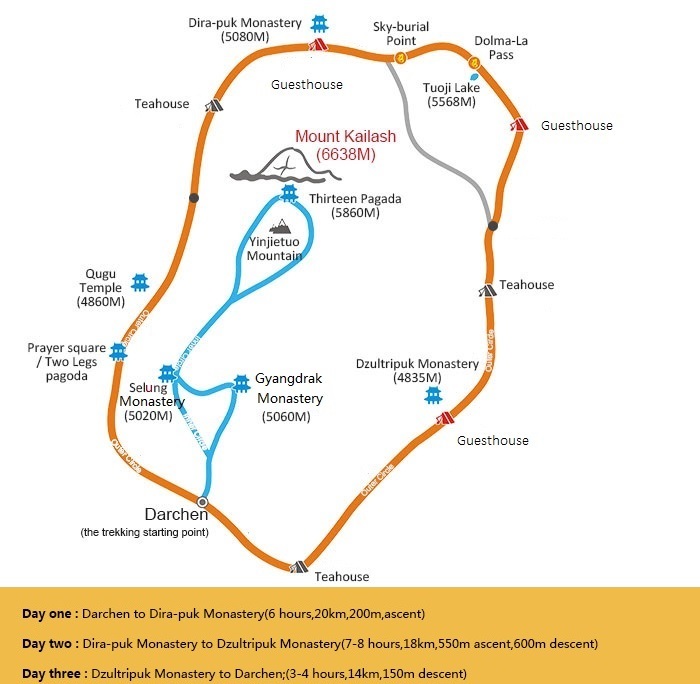
Day One: Darchen to Dirapuk Monastery(20km)
The starting point of the Kora around Mt. Kailash is Darchen. Darchen is a village in Purang County. Situated right in front of Mt. Kailash, it is 4,575 meters above sea level. The goal on the first day is to trek from Darchen to Dirapuk Monastery. This trail stretches 20 kilometers and takes six hours to complete. Alternatively, you can take an eco-bus for the first 5 kilometers to the memorial(The Two-legged Pagoda).
The ideal time to start this trek is from early morning. From the square in Darchen, you will begin the long trek to Dirapuk Monastery. At Darchen, you can hire a porter and yak to transport your day packs.
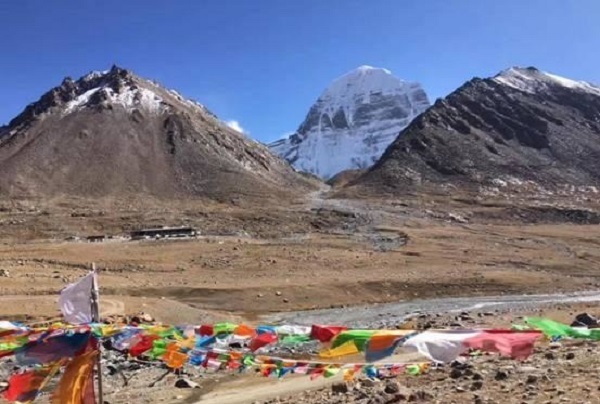
The trek to Dirapuk can be subdivided into two segments: Darchen to Qugu Temple and Qugu Temple to Dirapuk Monastery. The first segment is around 6 kilometers long and may take two to three hours to complete. It is characterized by a slow ascent with little ups and downs trails, which can be easily managed by most tourists. After trekking for four kilometers from west Darchen, you will notice that the trek will begin to ascend. Then, you will reach the memorial at 4,740 meters. This memorial is filled with varied-colored flags. Here, you can view Mt. Kailash's southern face. This is also the first prostration point of the Kora.
Along the way, you'll pass by some ruined chörtens. You'll also pass along prayer walls. Soon after, you will be crossing the Lha-Chu river via a small bridge. At this point, you have already walked around three hours. From the bridge, you will see the Qugu Temple high above the valley on the west.
From the Qugu Temple, it will take three to four hours to reach Dirapuk. This segment is replete with awesome views, and you will surely enjoy these views along the way.
The Qugu to Dirapuk Monastery trail segment stretches 14 kilometers. You can complete this segment within six to eight hours. It contains a mild to moderate segment. Afterward, the trail moves along the Lha-Chu Valley up to the Dirapuk Monastery. You will stay overnight at the Dirapuk Monastery for a good night's rest.
Day Two: Dirapuk Monastery to Dzultripuk Monastery(22km)
The second day is the most challenging part of the trek! From Dirapuk Monastery to Dzultripuk Monastery, the route covers a distance of 22 kilometers with drastic ascent and descent of almost 600 meters, which takes around 11 to 14 hours to complete. The highlights of this trek are the Sky Burial Point (4km away) and the Dolma La Pass at around 5630 meters high.
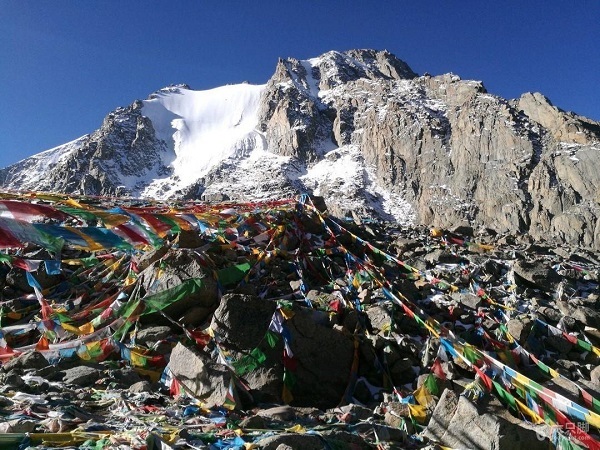
After waking up in the morning, you can then start your second-day trek. The usual course is to head off towards the east. You will once again cross the Lha-Chu River. Afterward, you will climb up to a moraine where you will meet the trail on the other side of the river. The trail then starts to ascend toward Dolma-La.
About two hours from the Dirapuk Monastery, you will reach the Shiva-Tsai (5,330m). Here, pilgrims are said to enter the realm of the dead by undergoing a symbolic death. This point is also called the “Sky Burial Point.” After 30 minutes of walking, you will then turn eastward towards Dolma La Pass. Dolma-La Pass is perched high at 5,630 meters. Here, most pilgrims pause and rest. You should not stay long at Dolma-La for the thin cold air may get you sick. Then, you will take a long and steep descent down to the grassy bank of Lam-chu River.
You got trail options here. You can choose trails either on the eastern or western side of the river. The eastern trail, however, affords you more tantalizing sceneries. It also provides clearer trails, yet it also requires you to hop from one boulder to another. Then, you will proceed for three hours until you reach some grassy fields. Here, you can set up your tent and camp for a while. From here, Dzultripuk Monastery is just an hour's trek. At Dzultripuk Monastery, there is also a simple guesthouse where you can spend the night for a fee.
Day Three: Dzultripuk Monastery to Darchen(12km)
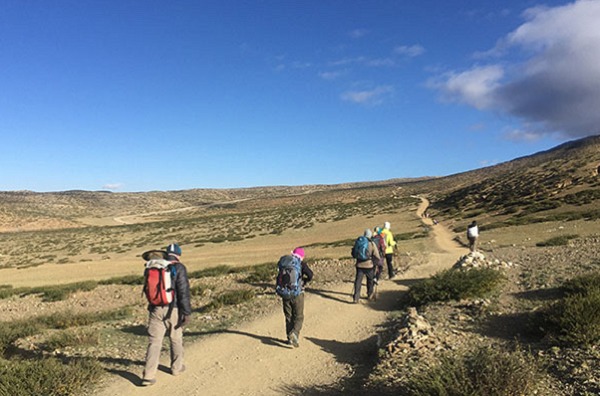
The trek from Dzultripuk Monastery to Darchen usually takes three to five hours. It stretches for 12 kilometers and involves a 150-meter descent. Hence, this is not as difficult as the second-day trek. And you can take an eco-bus for the last 3 kilometers.
Early in the morning, you can start moving away from the Dzultripuk Monastery. The route at the onset closely follows the slithering river. After an hour of trekking, the trail reaches a narrow canyon. You will notice some holes carved along the cliff walls of the canyon. These holes were made by some pilgrims who were searching for sacred stones.
From the distance, you'll see the turquoise waters of Lake Raksas Tal. Across the river, you'll also see flags that are set by the pilgrims. After continuing with the trail, you'll then emerge into the Barkha plain. From there, the trail becomes easy and bearable. Thereafter, you can take the dirt road that leads back to Darchen. Once you've reached Darchen, you have now completed the Kora around Mt. Kailash which is a very important pilgrimage for four religions.
Altitude Changes of the Mt. Kailash Kora
The elevation change chart of Mt.Kailash Kora is in the shape of a pyramid. The starting point and the endpoint is Darchen, which is relatively low, at about 4675 meters. Then the elevation gradually rises until it reaches the highest point, the Dolma La Pass, at 5,660 meters. After that, the altitude showed a gradual downward trend, until it returns to Darchen Town.
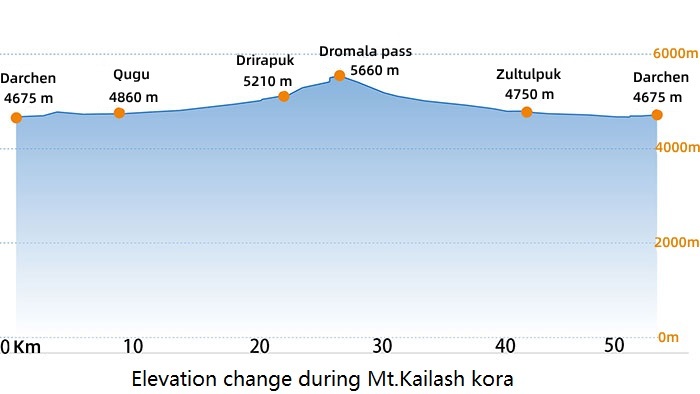
Permits for Mt.Kailash Trek
Due to the regulations of the government, international tourists must be accompanied by a local guide when traveling in Tibet. So you need to book your Kailash tour (vehicle, driver and guide) with a local Tibet Travel Agency in advance. When your tour gets closer, your travel agency will take up to a month to secure your Tibet Travel Permit, Alien's Travel Permit and Military Permit, without which you cannot trek Mount Kailash. Before departing to Tibet, you need to get your Tibet Travel Permit either in China or in Nepal. In addition, you also need a valid China Visa (from China mainland) or a Chinese Group Visa (from Nepal). Great Tibet Tour can obtain all the permits for you.
For Indian tourists, if you are going to Ngari to make a pilgrimage to Mount Kailash and Lake Mansarovar, you need to turn to two organizations instead of Tibet travel agencies. The first one is the Foreign Affairs Office of TAR (governmental); the second one is the pilgrimage Reception Center (non-governmental), short for the PilgrimageCenter, which is located in Tuanjie New Village of Lhasa. Besides, you also can book your Ngari tours through Nepal or Indian Travel Agencies as they are authorized partners of the Pilgrimage Center. We can also provide free consultations for you.
Conclusion
Trekking to mount Kailash, you will follow the footsteps of countless pilgrims for thousands of years and circuit the holy mountain. After experiencing high altitude hypoxia, breathing difficulties, muscle soreness, chapped lips, skin sunburn and other hardships, you can feel indescribable happiness and satisfaction from the kora.
Email response within 0.5~24 hours.


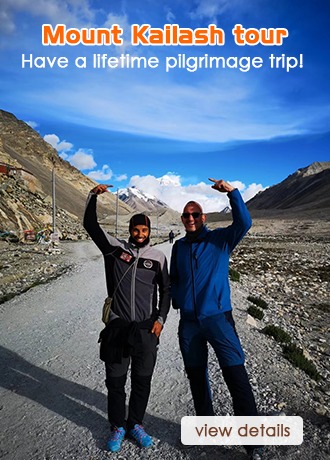
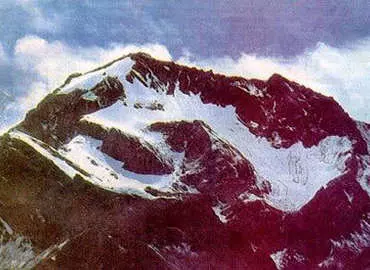
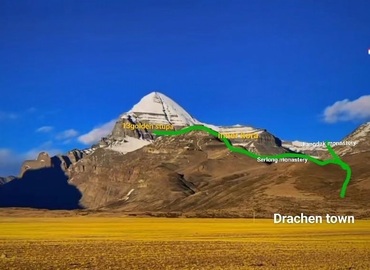
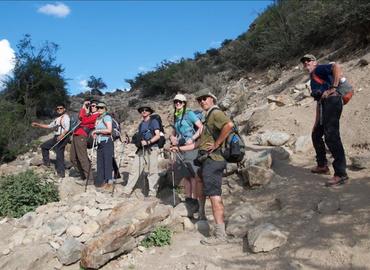
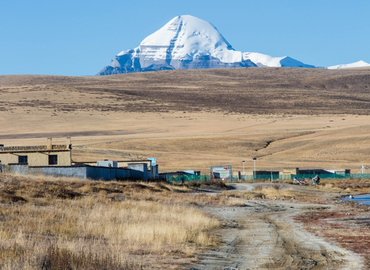

Typically Asked Questions from Our Clients
Asked by patr***
I am interesting in getting details about this trek of october 2025 ( dates can be flexible ) for 1 person. but i would like to do the trek in more days so it breaks it a bit and make it less strenuous and give me more time at the mountain.
Would it be a possibility?
is there a minimun group size?
Dear Patr****,
We can arrange the Mt.Kailash trekking tour for you in early October. If you join the group, the group itinerary is fixed and we can't arrange more days for trekking. If you want less strenuous, you can trek one day and then return to Darchen to wait for other tourists. We can open a group departure for you in early October and need further confirmation. Our group is open based on 3 pax.
Asked by Dani***
Hi, we would like to go to mount Kailash and do the trekking, maybe other friends will come. We would like a secure but not expensive trip, thanks and regards
Dear Daniela,
I recommend Kailash group tours with trekking, which are secure and not so expensive. We can open one departing date on 1st August 2025 for you.
Below are two itineraries for your reference. Which one do you prefer? I can quote you accordingly in the next email.
Option I- 12 Days Lhasa Mt Everest & Mt Kailash Kathmandu Group Tour
Option II- 15 Days Mt.Everest & Mt.Kailash Kora Pilgrimage Group Tour
Asked by M V ***
1. What is the best way for Indian tourists to complete the Kailash-Manasarovar tour?
2. Is there any age limit for tourists?
3. What is the approximate cost & duration?
Dear M V Kotwal,
Currently, according to the authorities, Mt.Kailash and Manasarovar Lake are not open to Indian passport holders. We can't arrange it now. I will let you know after it opens further.
Asked by Vikr***
We would like to do the 3 day trek but what is the quickest way to get there by chopper so we can do the trek
Dear Vikr****,
Taking a flight to Mt. Kailash is the quickest way, but it costs more. Regarding the high altitude, tourists are suggested to stay in Lhasa for at least two days.
Asked by Erin***
I would be interested in that trip at the end of May or early June for Mt Kailash trek/Kora. I don't care too much about a long tour, looking for the most direct route to the Mountain to spend time there but I understand a tour is necessary.
Dear Erin****,
As you travel alone, I suggest you consider joining a Kailash group tour. We have 12 days and 15 day Kailash group tours on 23 May and 16 June. Are you joining?
Below are the two itineraries for your reference.
1. 15 Days Mt.Everest & Mt.Kailash Kora Pilgrimage Group Tour
2. 12 Days Lhasa Mt Everest & Mt Kailash Kathmandu Group Tour
Read More ...